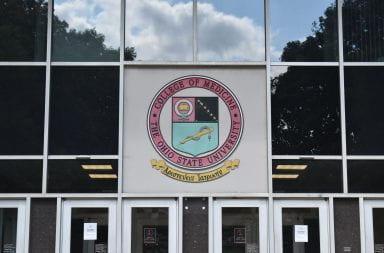
Karen Patricia Williams, a distinguished professor in the College of Nursing and a team member of E6. Credit: Courtesy of Ohio State
Ohio State faculty members have created a new community engagement model to link health disparities to poor health outcomes in the greater Columbus, Ohio, community, and it officially kicks off this week.
E6 is a new community engagement model developed by Darryl Hood, associate professor in the College of Public Health. The six E’s — enriching environmental endeavors via e-equity, education and empowerment — aim to expose why poor health outcomes have persisted at high proportions in Columbus for the past 50 years, Hood said.
Health disparities, such as violence, accessibility to drugs, pollution and air quality, can be precursors to poor community health in high-risk Columbus neighborhoods, Hood said. Continued exposure to these factors can lead to high rates of infant mortality, preterm births, low birth weight, obesity, cardiovascular disease and diabetes.
“People are victims of where they live, work, eat, play and pray,” Hood said.
Hood’s development and application of the model analyzes the high rates of health disparities in communities close to Ohio State: the King-Lincoln district and, more specifically, the Mount Vernon neighborhood.
Hood said the Columbus ZIP codes with the highest proportion of poor health outcomes are 43205 and 43207 — southeast and south Columbus, respectively.
E6 has refined the approach to community-based research and well-being, Hood said. Instead of assuming one cause of poor health outcomes, nurses, doctors and stakeholders work together to identify commonalities between disparities and outcomes. Then they determine intervention methods for the community.
As the team and initiative are still in the early stages, it is developing ways to ensure the community contributes to the project outlines for intervention methods, giving the methods a higher likelihood of being maintained, Hood said.
In order to make the E6 engagement model work, communities must participate, Karen Patricia Williams, distinguished professor in the College of Nursing and an E6 team member, said.
Hood said that because he and Williams rely on the community for their research, it is important that community members communicate what they need.
“It’s always refreshing when you hear from the community firsthand without any filters,” Williams said. “We learn from the community and we work with the community in doing the research.”
Hood’s team consists of researchers who are interdisciplinary in their specialties, which allows for greater understanding of how to address national health disparities that can be translated anywhere, Hood said.
Hood said his team of faculty has also partnered with clinics and institutions in Columbus to have as much reach as possible.
Gina Ginn, chief executive director at Columbus Early Learning Center and an E6 team member, said some Columbus neighborhoods experience extreme poverty and are right outside Ohio State classrooms.
Ginn said that because Ohio State is a land-grant university, it has a responsibility to ensure that the research, knowledge, science and findings developed are reaching each community involved in these studies.
“There’s still a world that exists outside of Ohio State, and there’s a thriving and connected world,” Ginn said.
The needs, culture and history are going to define what community members need and makes them who they are, Ginn said.
”It’s not a one-size-fits-all prescription that we can dose out and then expect the same outcome,” Ginn said.
The first intervention project will be a clinic stationed between the communities that have expressed a need for aid, Hood said. The clinic will be available from 10 a.m. to 5 p.m. every Friday and offer full obstetric and gynecological initial procedures beginning in February or March, Hood said.
There will be an open community outreach meeting from 5 to 8 p.m. Thursday at the African American and African Studies Community Extension Center.
The Engaged Scholars logo accompanies stories that feature and examine research and teaching partnerships formed between The Ohio State University and the community (local, state, national and global) for the mutually beneficial exchange of knowledge and resources. These stories spring from a partnership with OSU’s Office of Outreach and Engagement. The Lantern retains sole editorial control over the selection, writing and editing of these stories.



